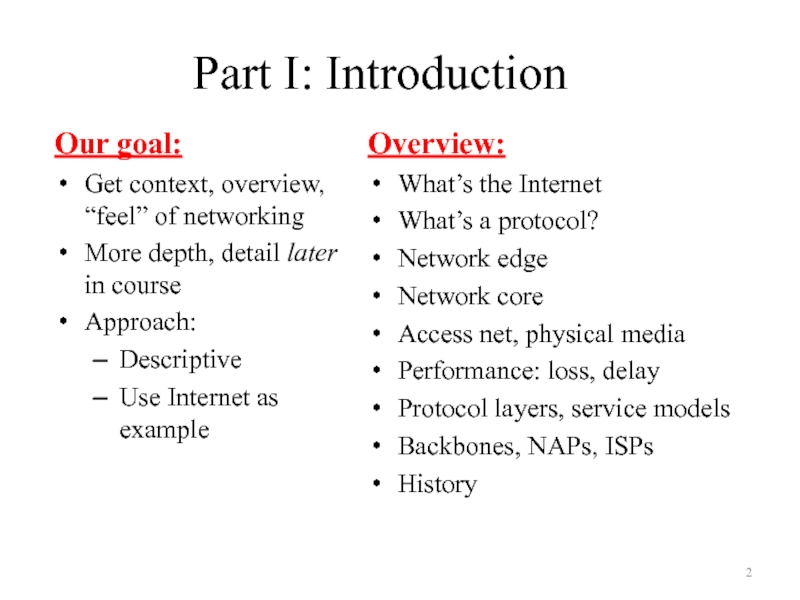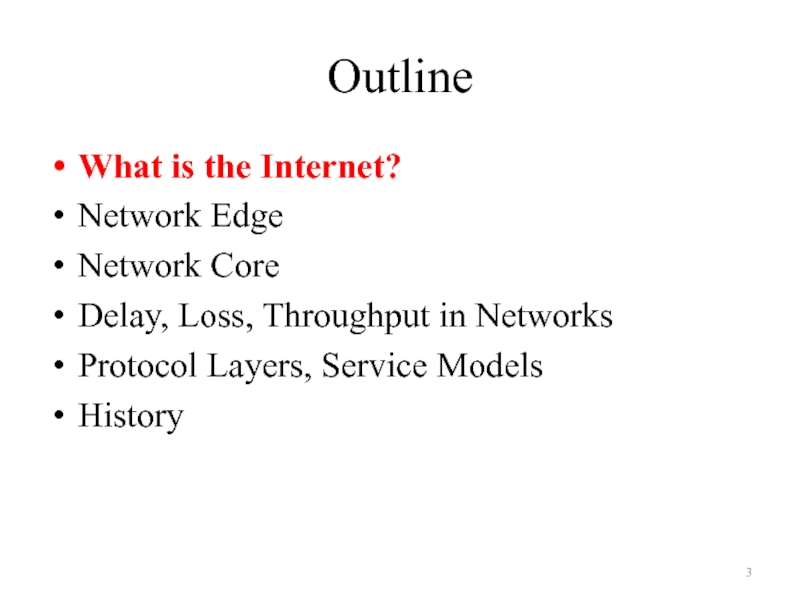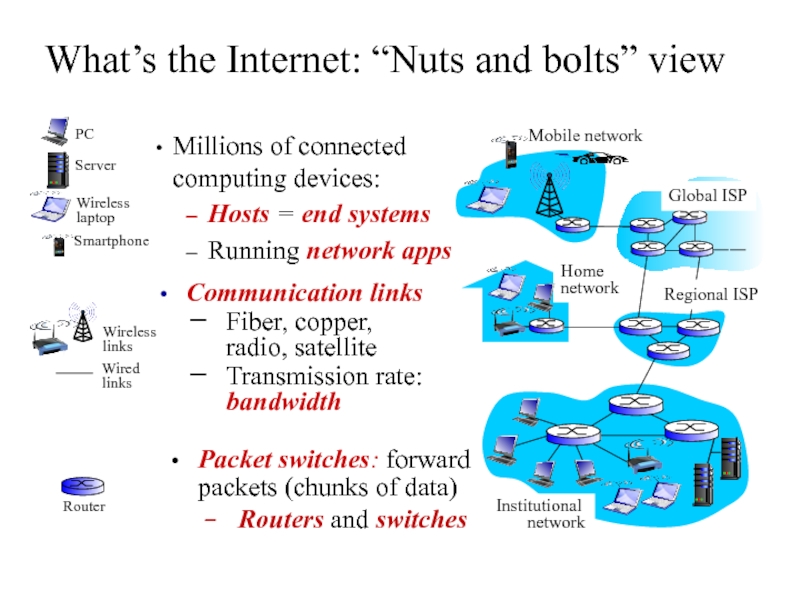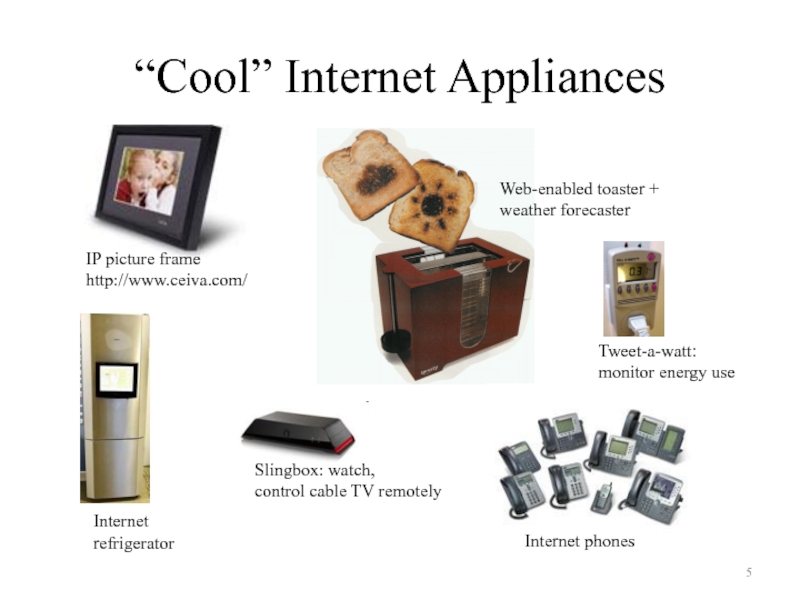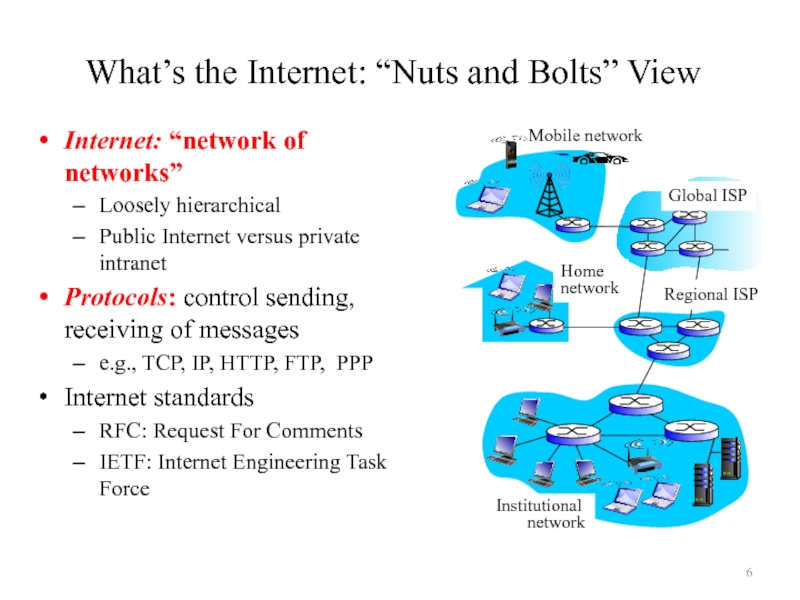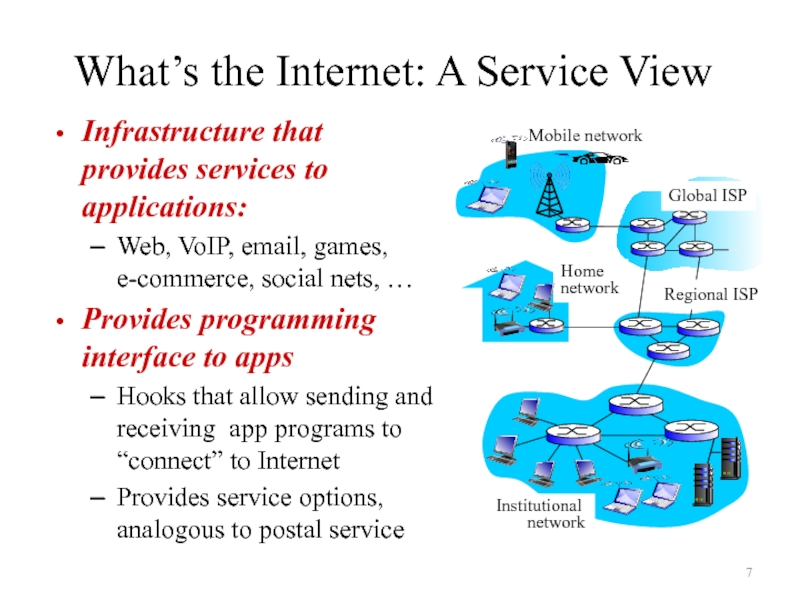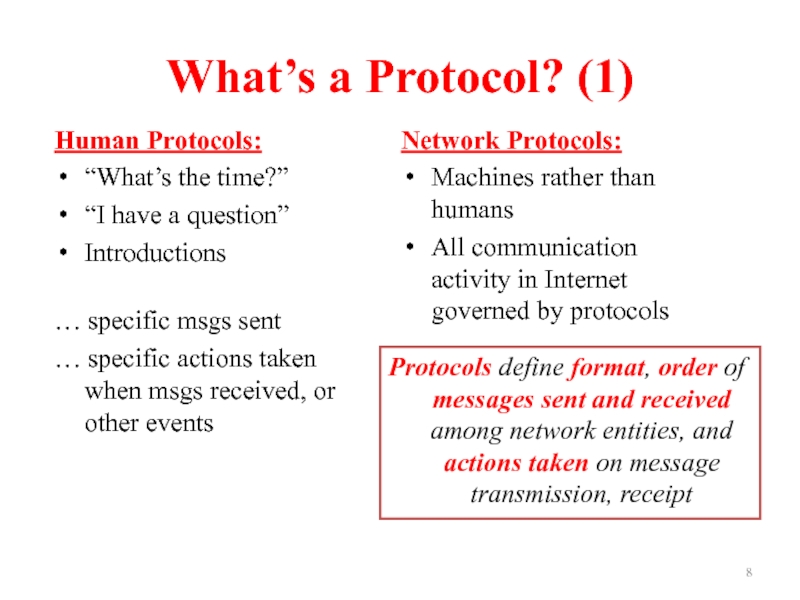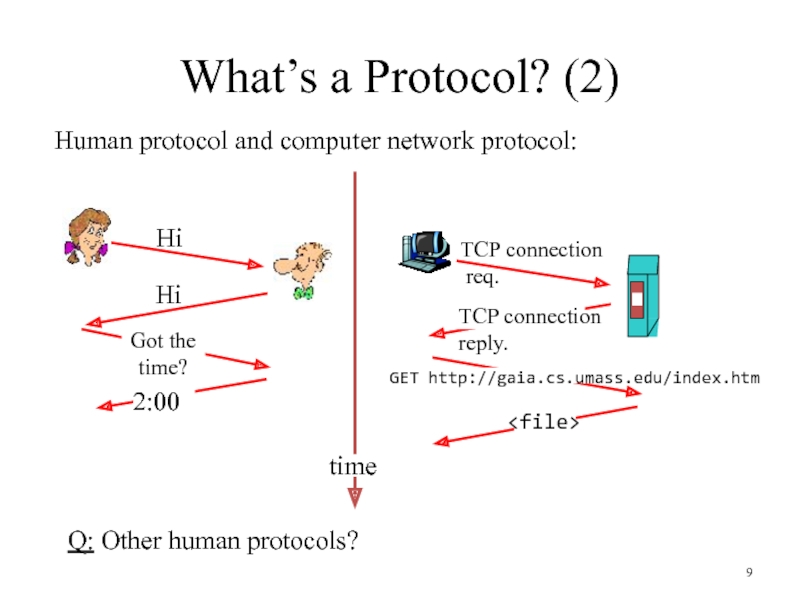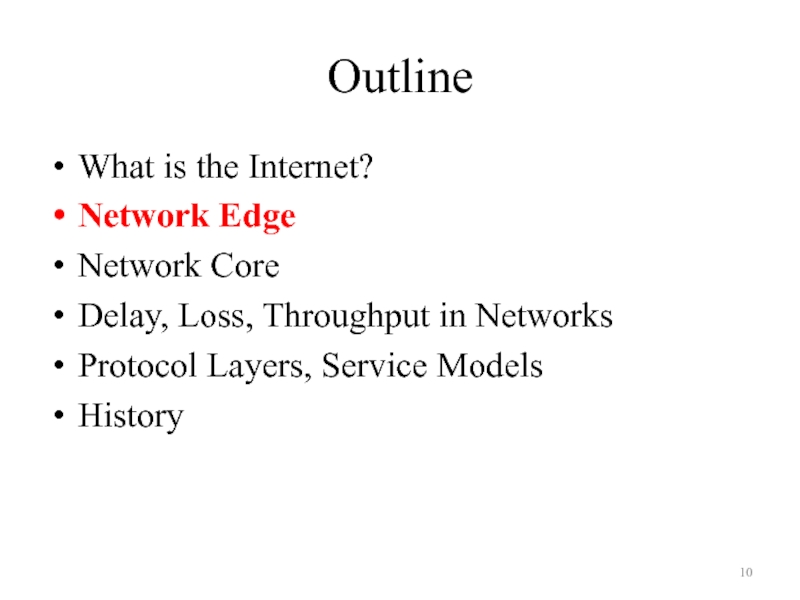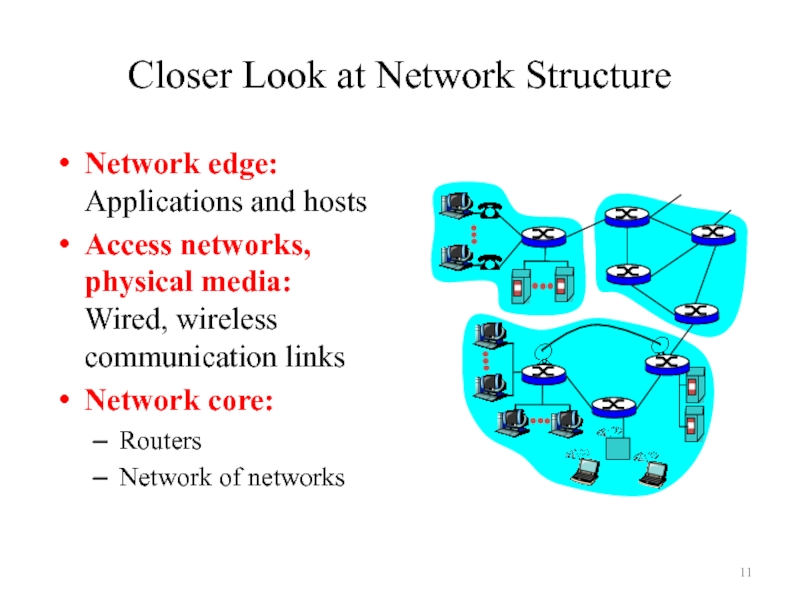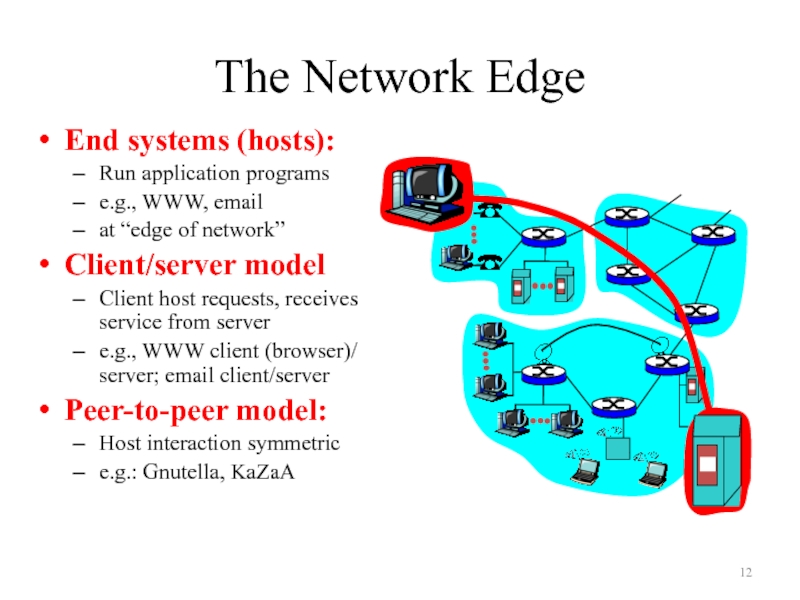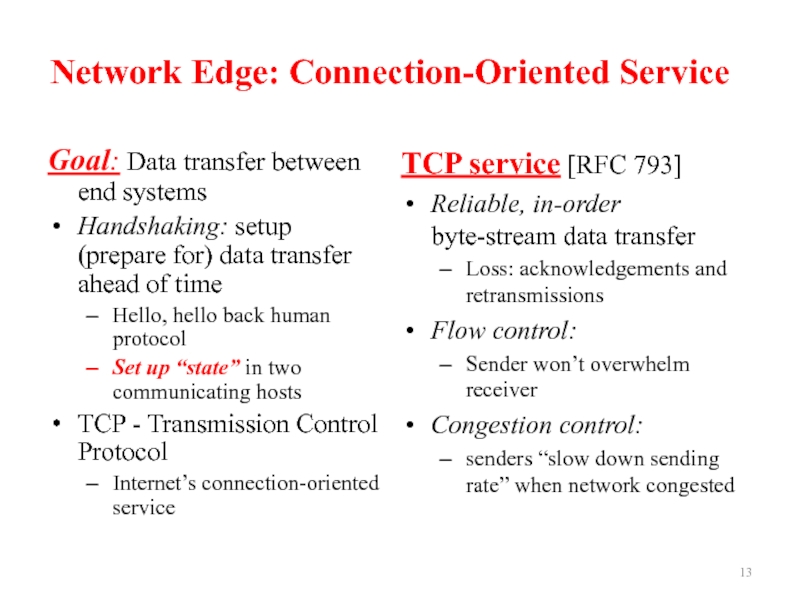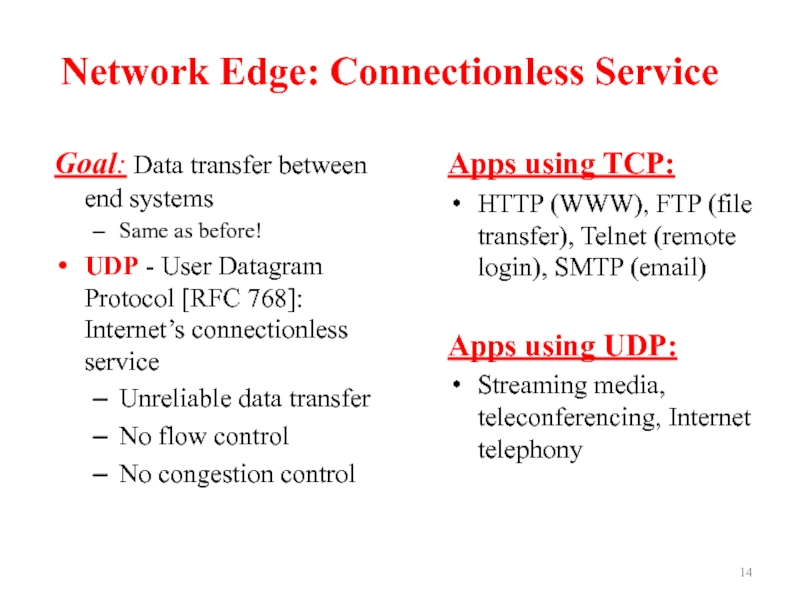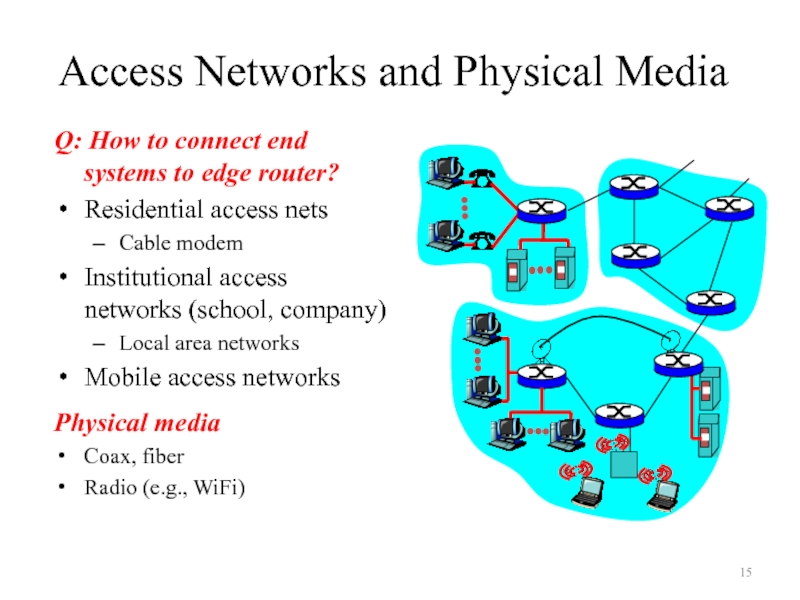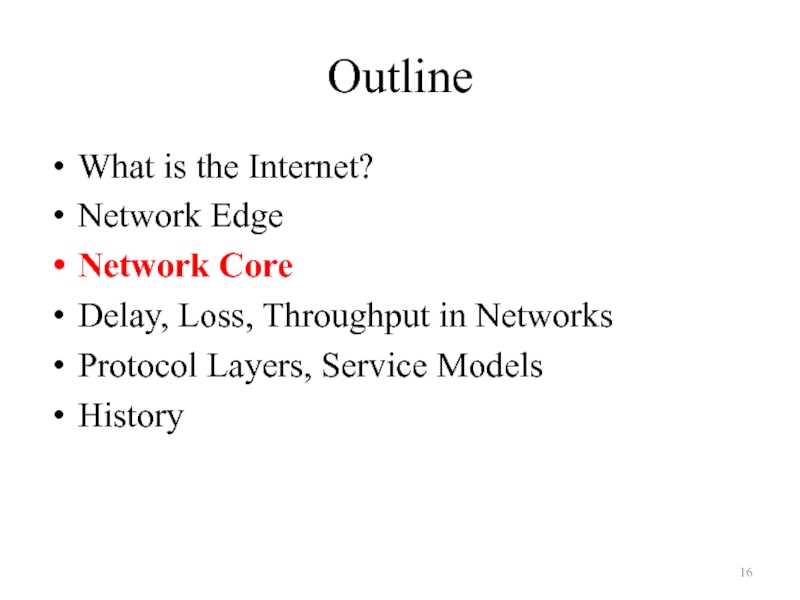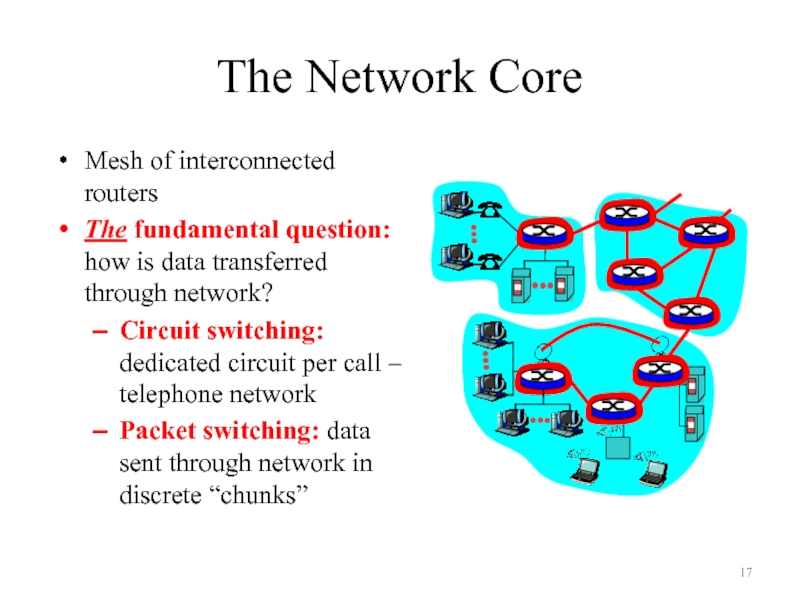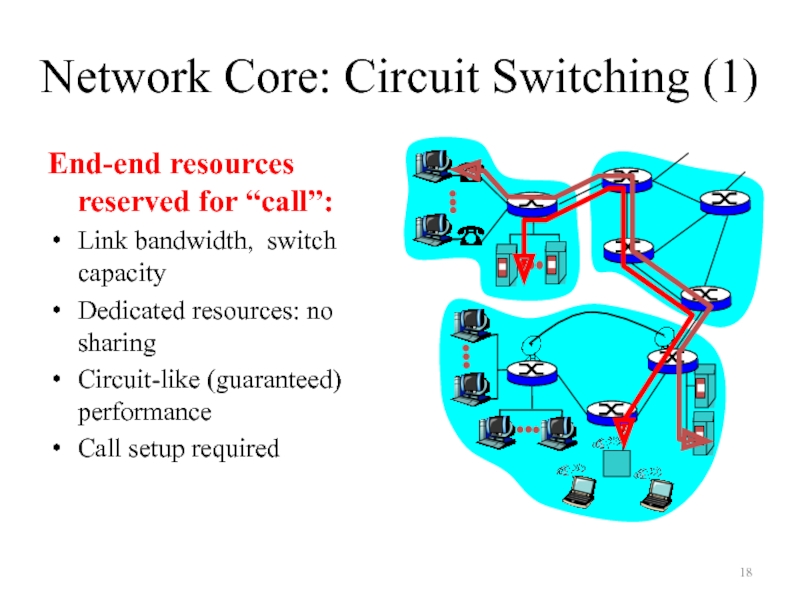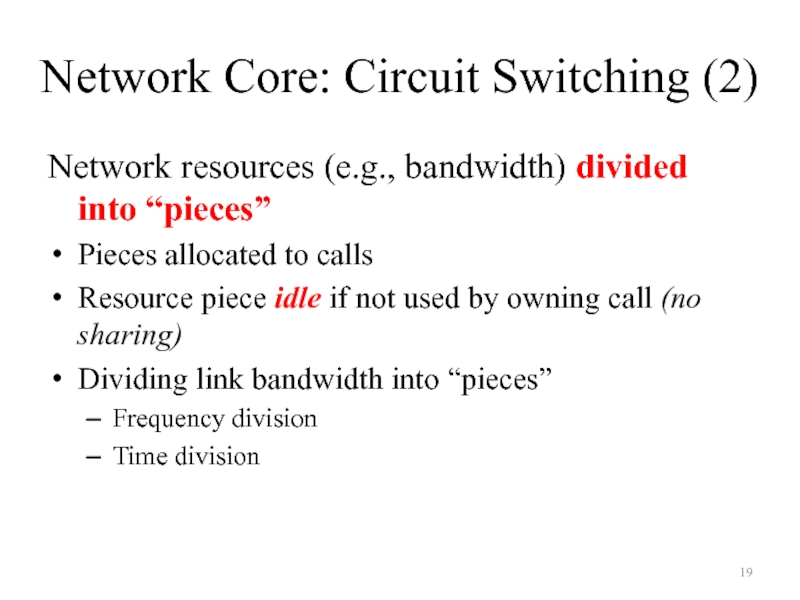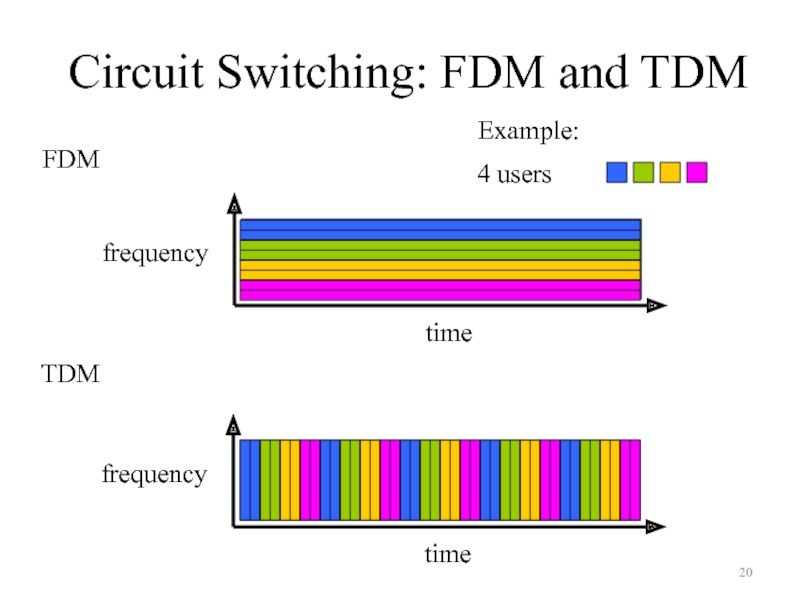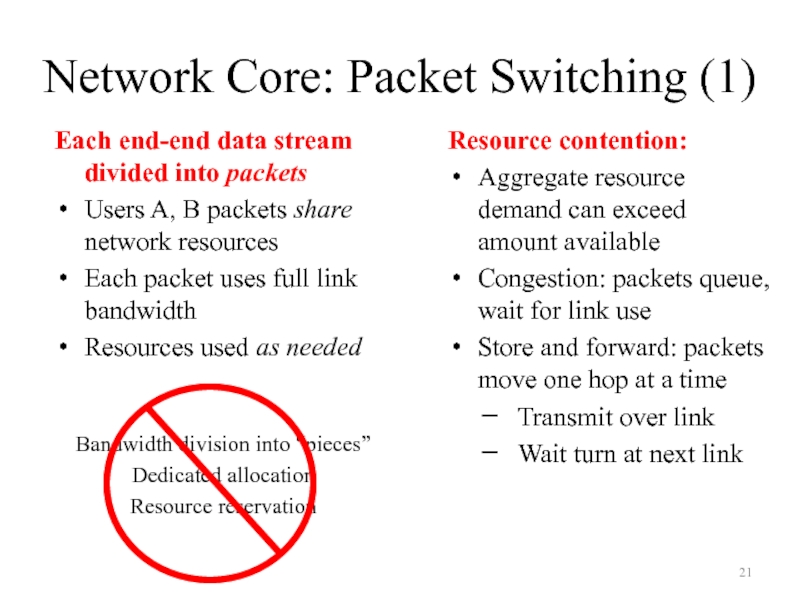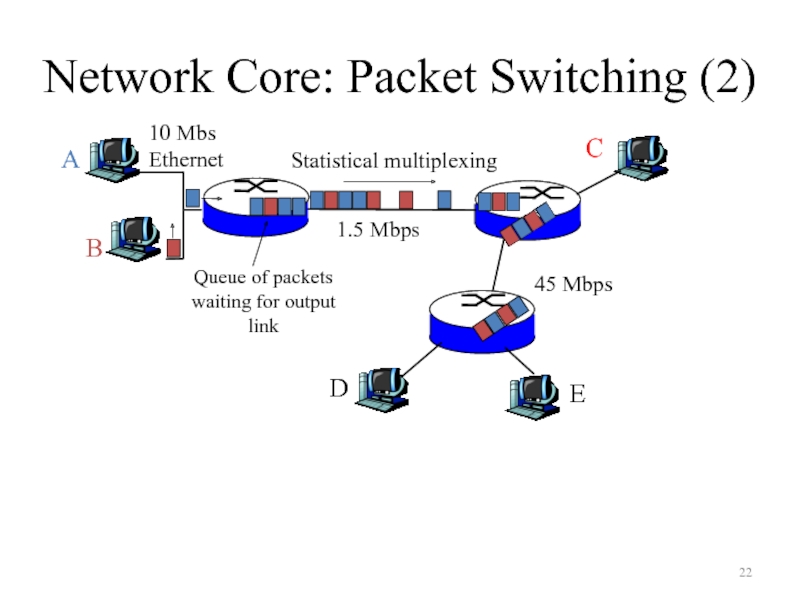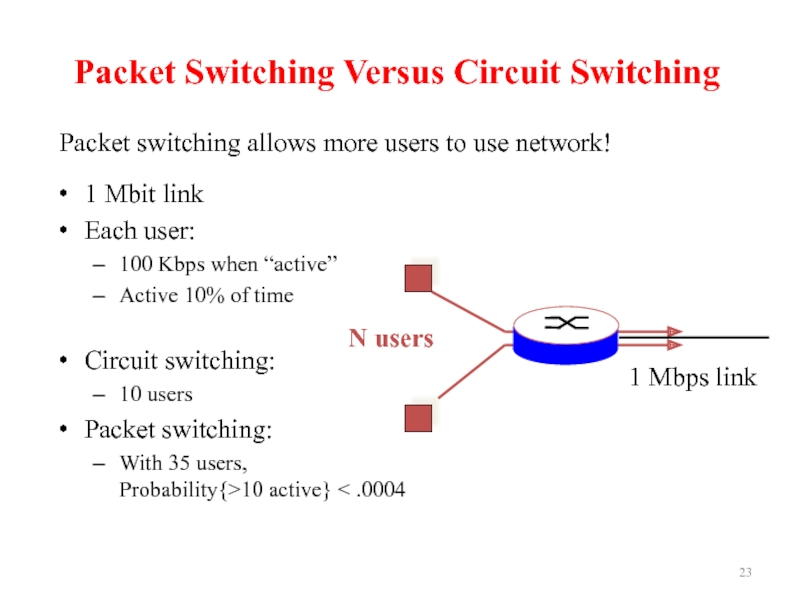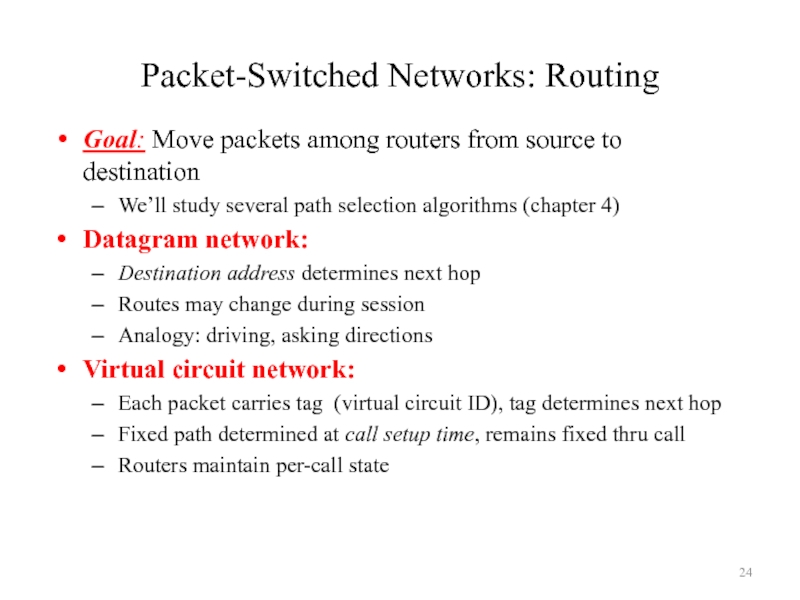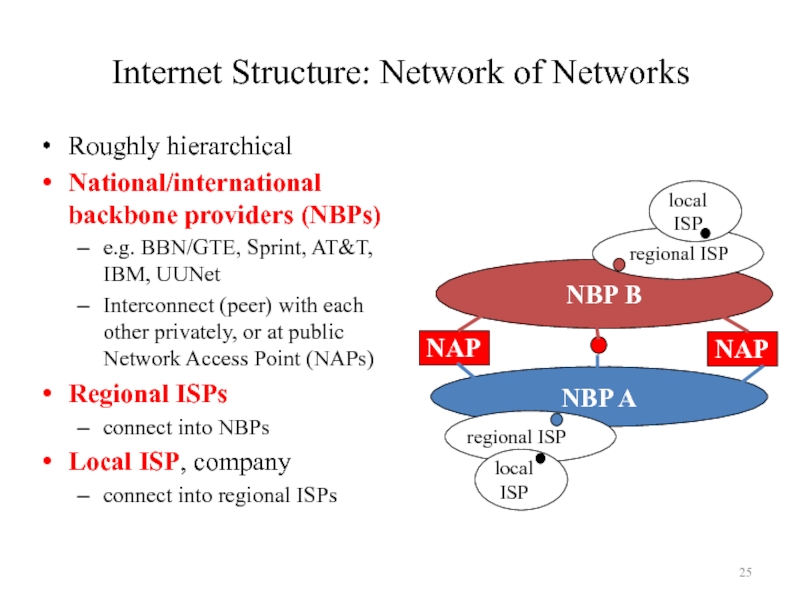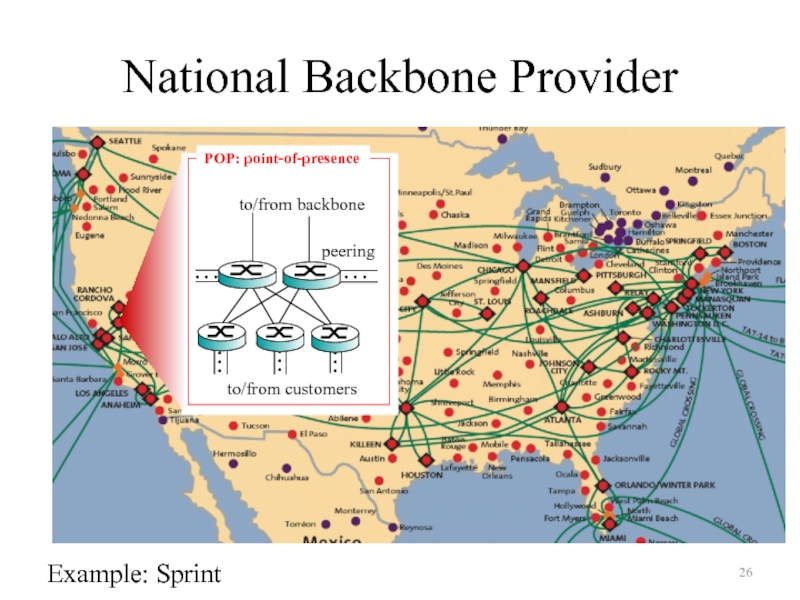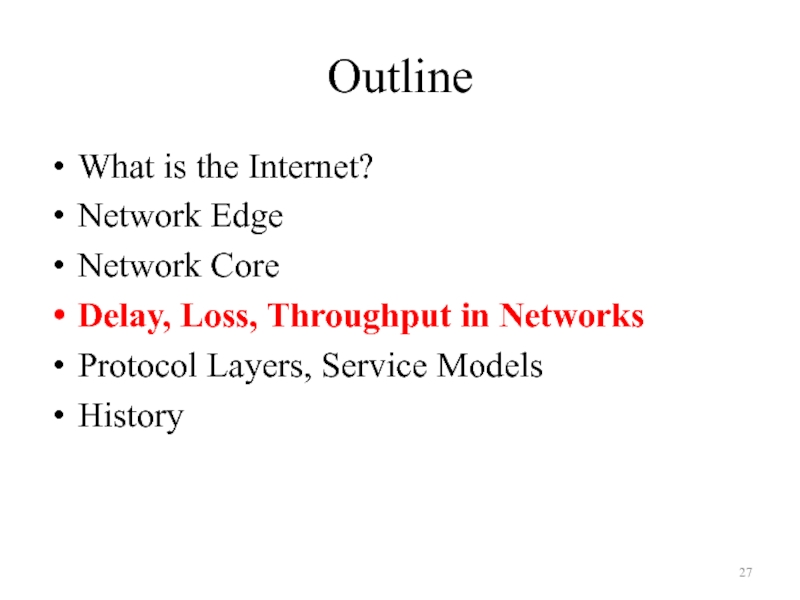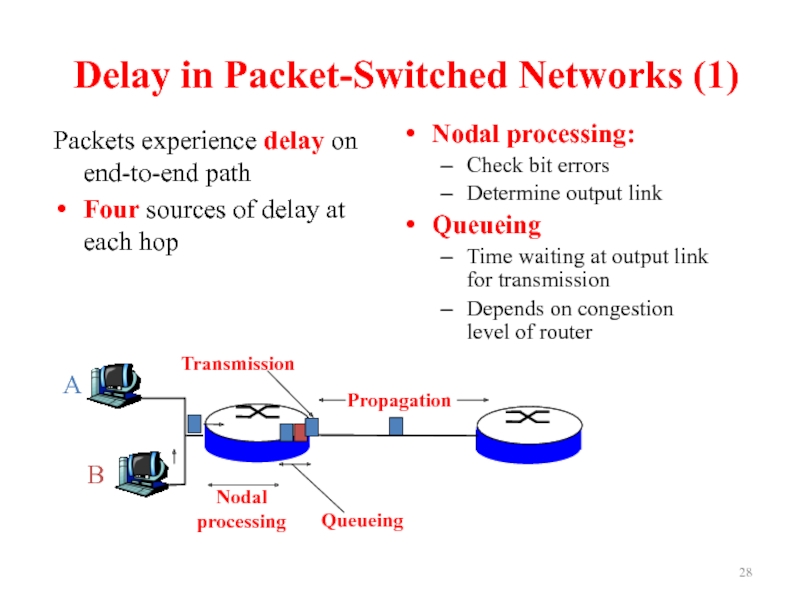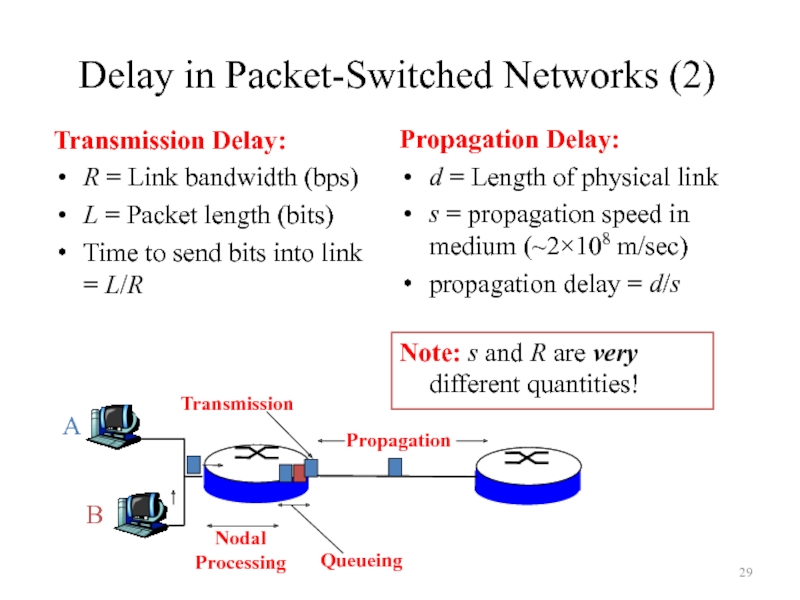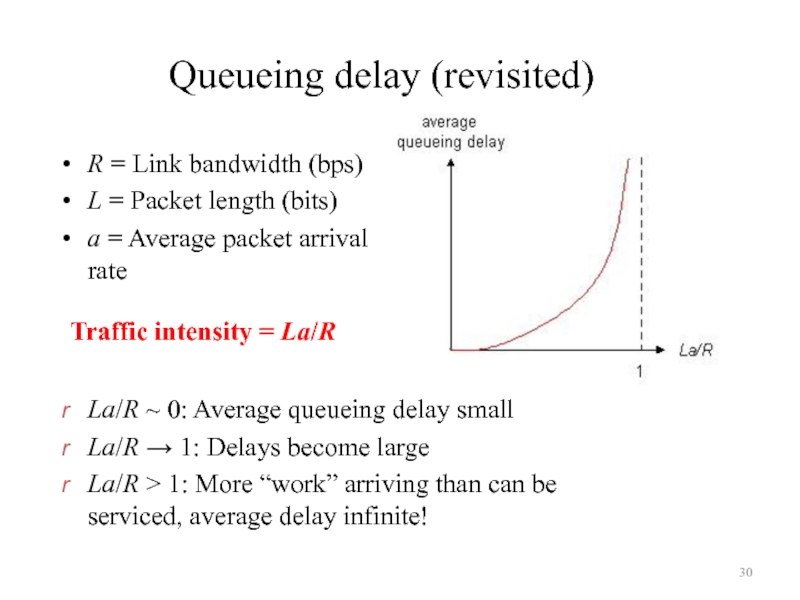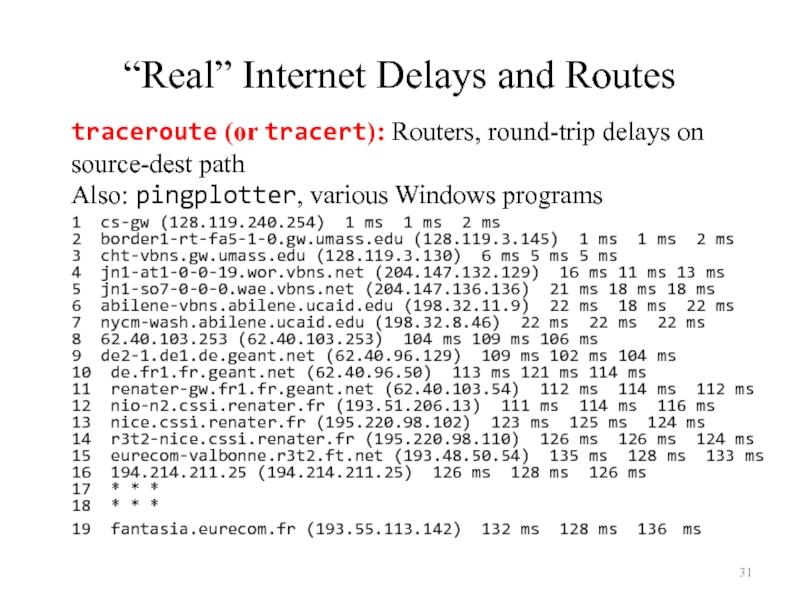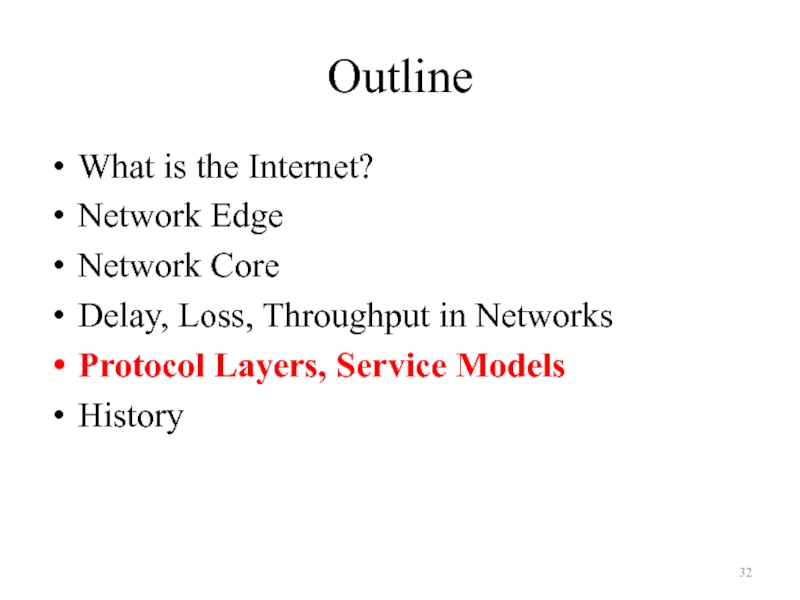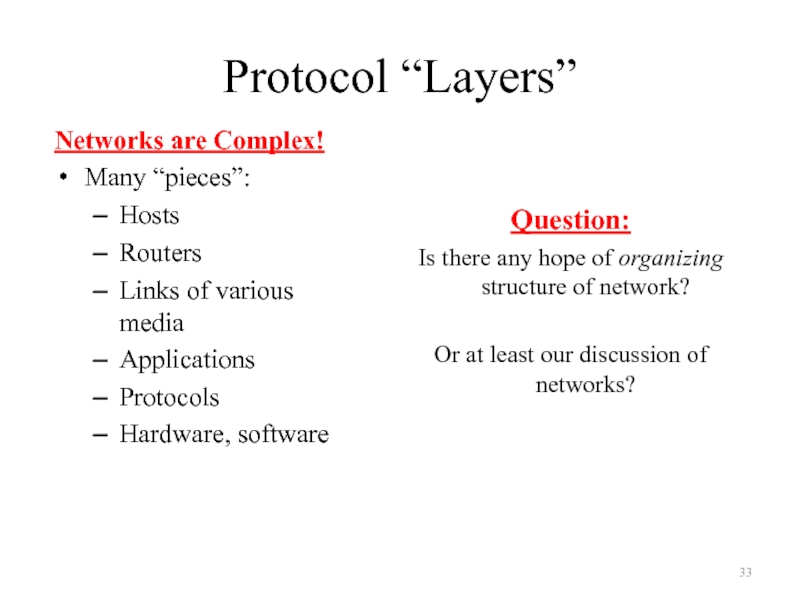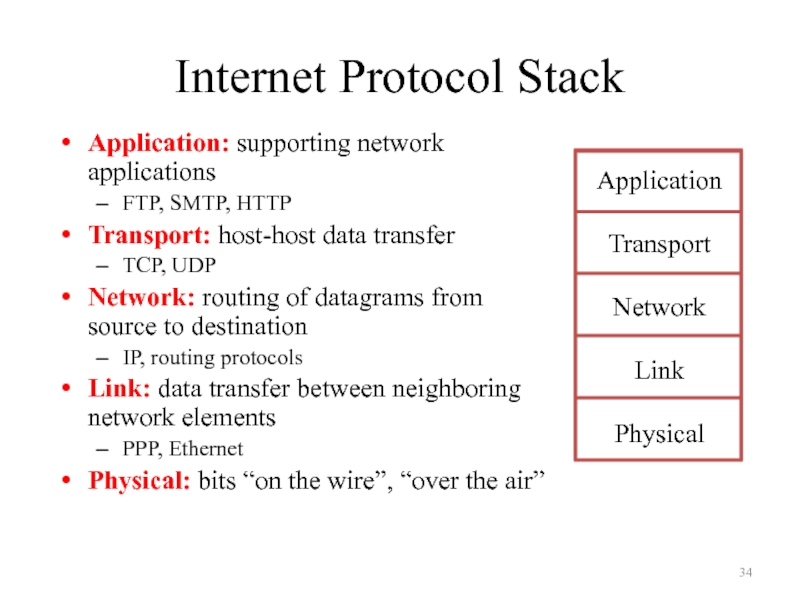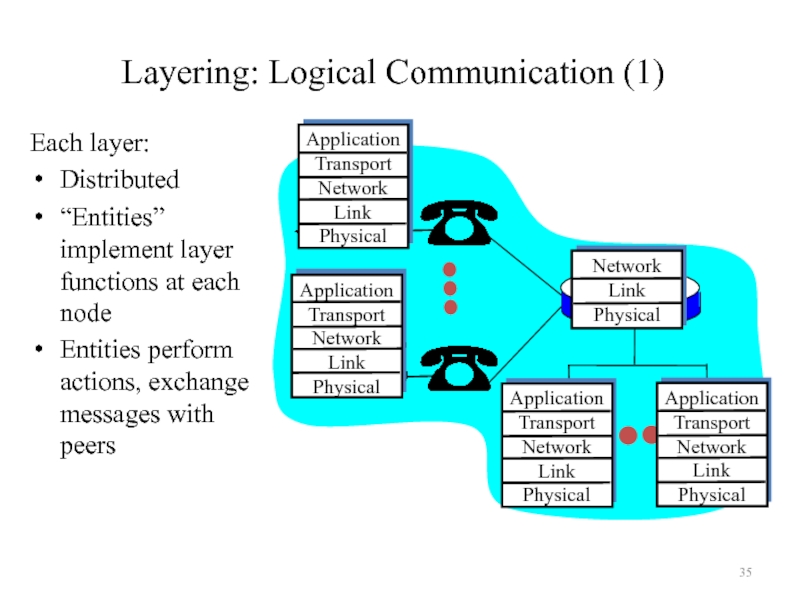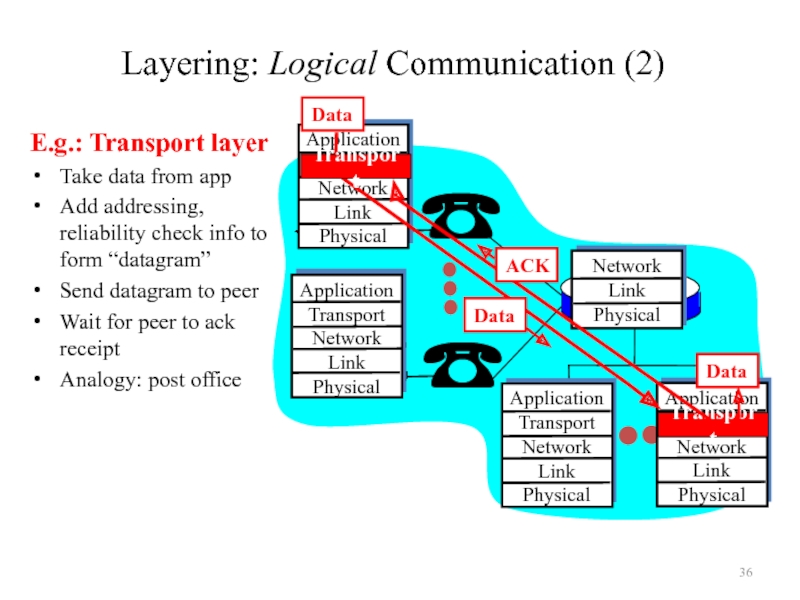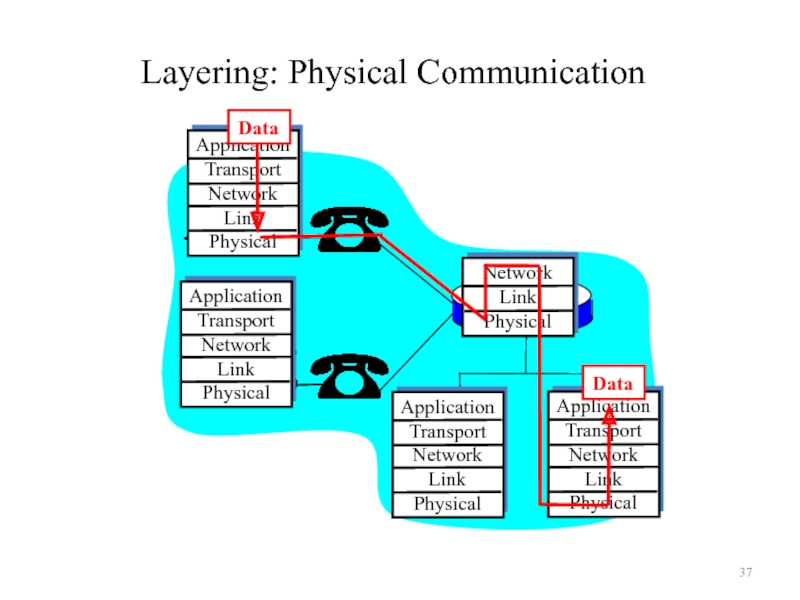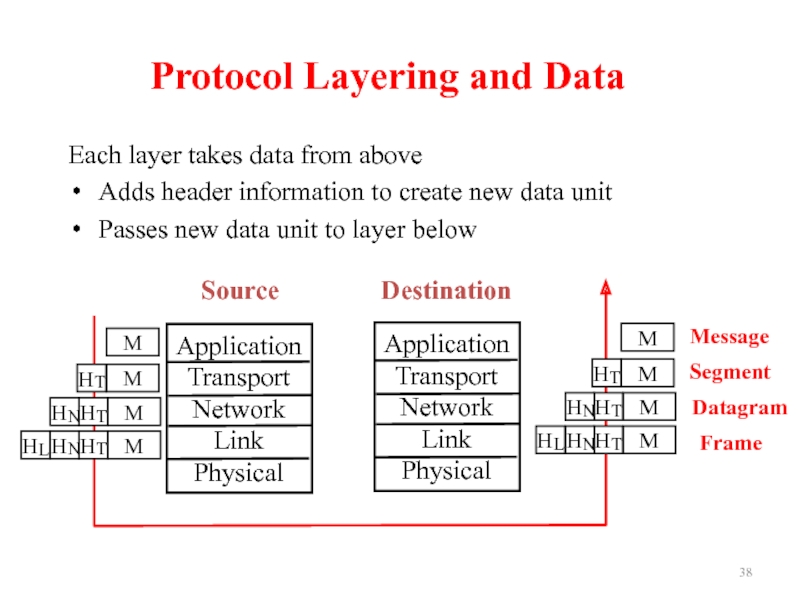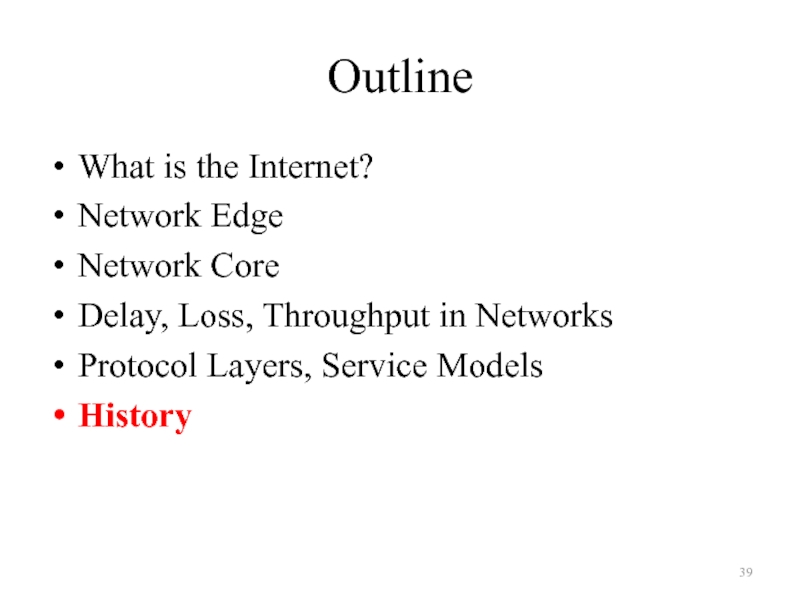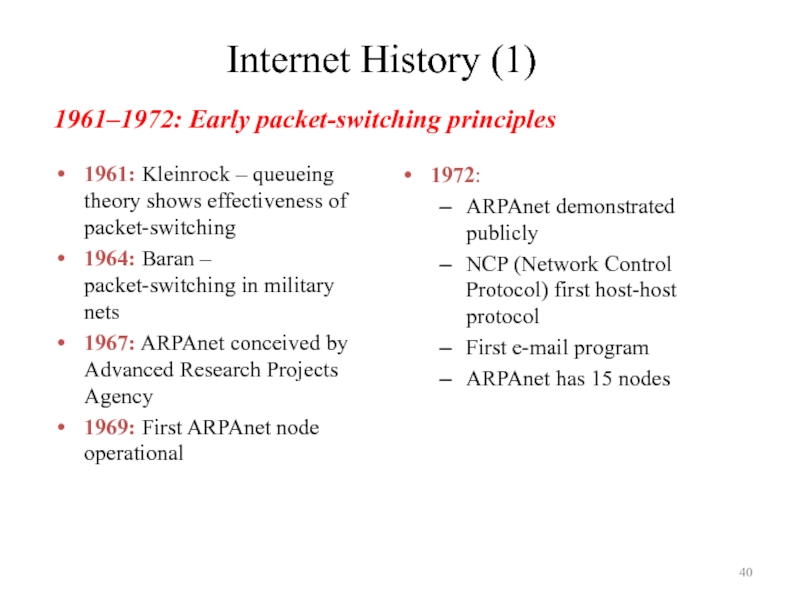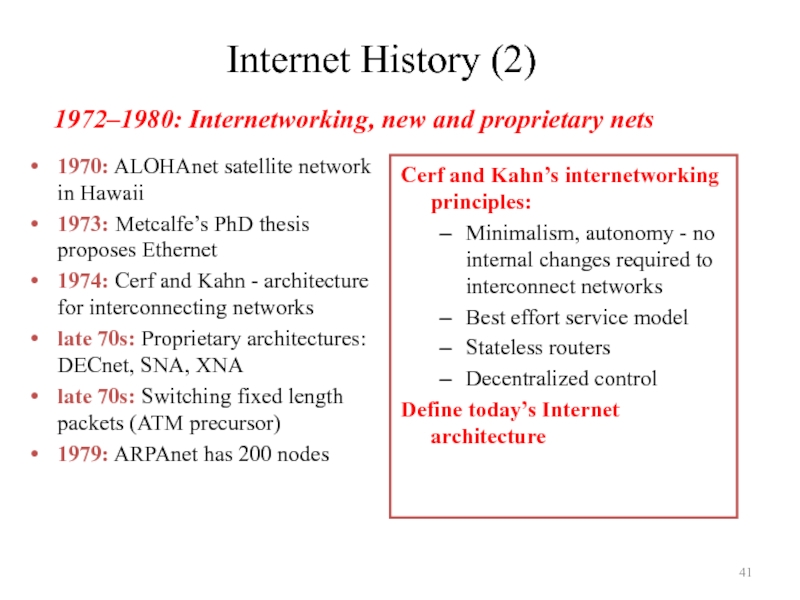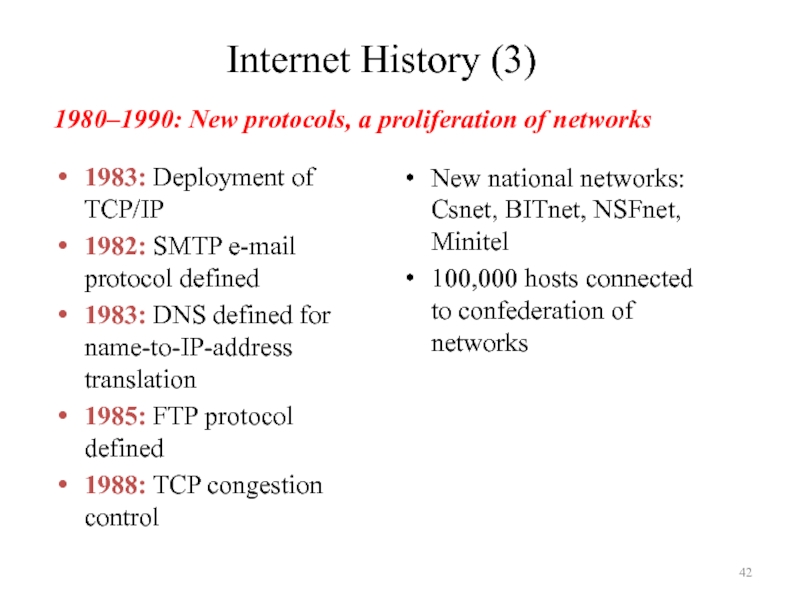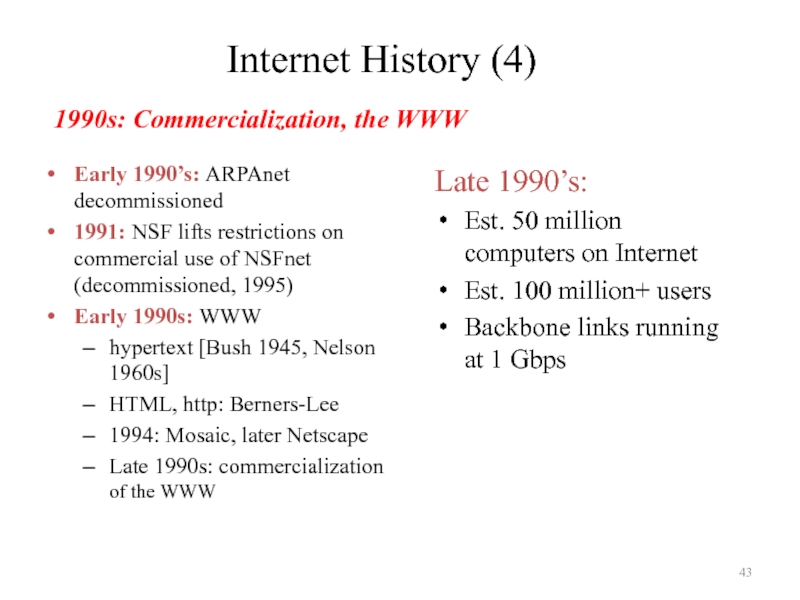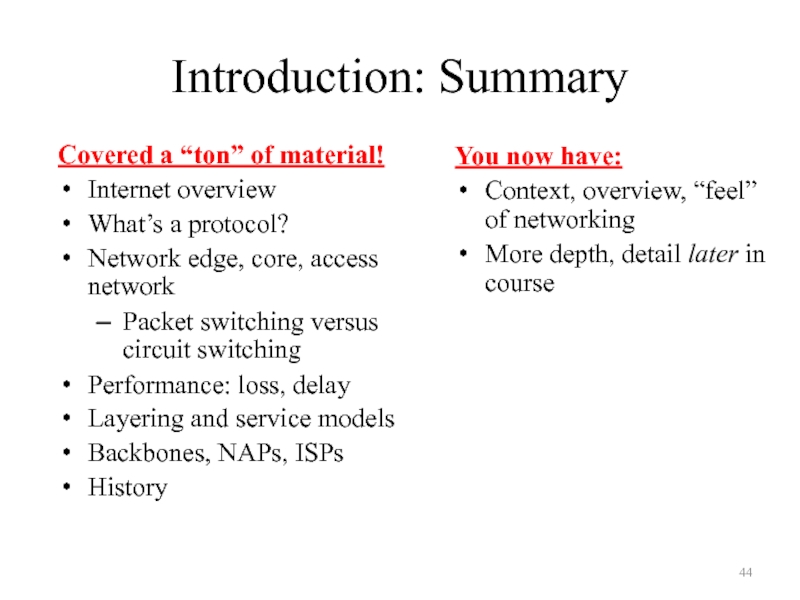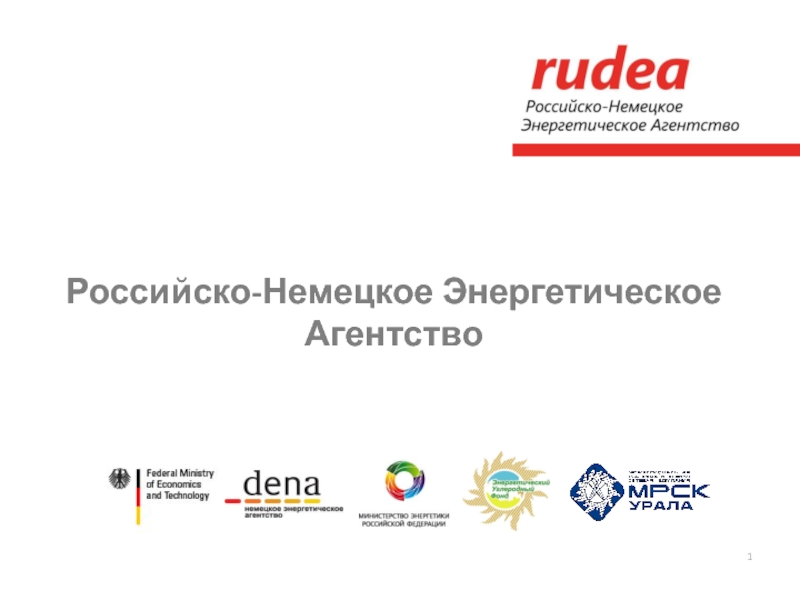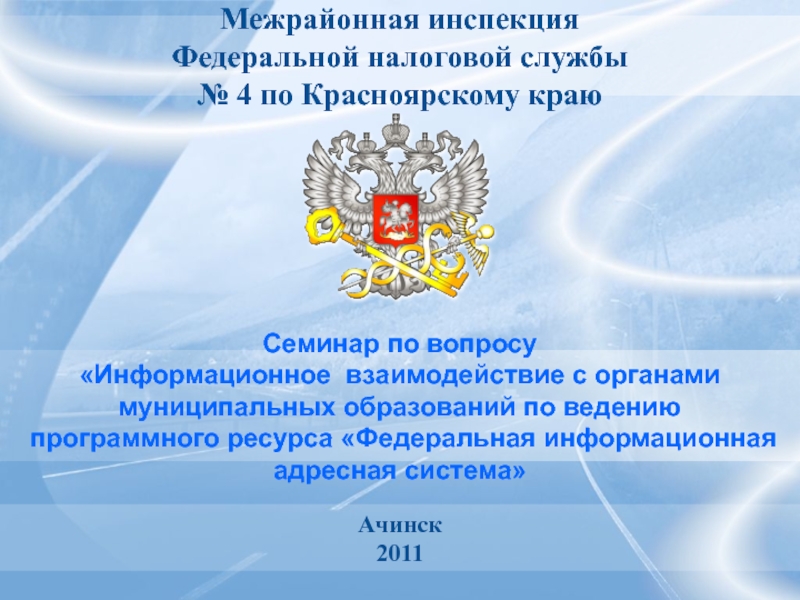- Главная
- Разное
- Дизайн
- Бизнес и предпринимательство
- Аналитика
- Образование
- Развлечения
- Красота и здоровье
- Финансы
- Государство
- Путешествия
- Спорт
- Недвижимость
- Армия
- Графика
- Культурология
- Еда и кулинария
- Лингвистика
- Английский язык
- Астрономия
- Алгебра
- Биология
- География
- Детские презентации
- Информатика
- История
- Литература
- Маркетинг
- Математика
- Медицина
- Менеджмент
- Музыка
- МХК
- Немецкий язык
- ОБЖ
- Обществознание
- Окружающий мир
- Педагогика
- Русский язык
- Технология
- Физика
- Философия
- Химия
- Шаблоны, картинки для презентаций
- Экология
- Экономика
- Юриспруденция
What’s the Internet презентация
Содержание
- 1. What’s the Internet
- 2. Part I: Introduction Our goal: Get
- 3. Outline What is the Internet? Network Edge
- 4. What’s the Internet: “Nuts and bolts” view
- 5. “Cool” Internet Appliances IP picture frame http://www.ceiva.com/
- 6. What’s the Internet: “Nuts and Bolts” View
- 7. What’s the Internet: A Service View Infrastructure
- 8. What’s a Protocol? (1) Human Protocols: “What’s
- 9. What’s a Protocol? (2) Human protocol and
- 10. Outline What is the Internet? Network Edge
- 11. Closer Look at Network Structure Network edge:
- 12. The Network Edge End systems (hosts): Run
- 13. Network Edge: Connection-Oriented Service Goal: Data transfer
- 14. Network Edge: Connectionless Service Goal: Data transfer
- 15. Access Networks and Physical Media Q: How
- 16. Outline What is the Internet? Network Edge
- 17. The Network Core Mesh of interconnected routers
- 18. Network Core: Circuit Switching (1) End-end resources
- 19. Network Core: Circuit Switching (2) Network resources
- 20. Circuit Switching: FDM and TDM
- 21. Network Core: Packet Switching (1) Each end-end
- 22. Network Core: Packet Switching
- 23. Packet Switching Versus Circuit Switching 1 Mbit
- 24. Packet-Switched Networks: Routing Goal: Move packets among
- 25. Internet Structure: Network of Networks Roughly hierarchical
- 26. National Backbone Provider e.g. Sprint US backbone network Example: Sprint
- 27. Outline What is the Internet? Network Edge
- 28. Delay in Packet-Switched Networks (1) Packets experience
- 29. Delay in Packet-Switched Networks (2) Transmission Delay:
- 30. Queueing delay (revisited) R = Link bandwidth
- 31. “Real” Internet Delays and Routes 1 cs-gw
- 32. Outline What is the Internet? Network Edge
- 33. Protocol “Layers” Networks are Complex! Many
- 34. Internet Protocol Stack Application: supporting network
- 35. Layering: Logical Communication (1) Each
- 36. Layering: Logical Communication (2) E.g.:
- 37. Layering: Physical Communication
- 38. Protocol Layering and Data Each layer takes
- 39. Outline What is the Internet? Network Edge
- 40. Internet History (1) 1961: Kleinrock – queueing
- 41. Internet History (2) 1970: ALOHAnet satellite network
- 42. Internet History (3) 1983: Deployment of TCP/IP
- 43. Internet History (4) Early 1990’s: ARPAnet decommissioned
- 44. Introduction: Summary Covered a “ton” of material!
Слайд 2Part I: Introduction
Our goal:
Get context, overview, “feel” of networking
More depth,
Approach:
Descriptive
Use Internet as example
Overview:
What’s the Internet
What’s a protocol?
Network edge
Network core
Access net, physical media
Performance: loss, delay
Protocol layers, service models
Backbones, NAPs, ISPs
History
Слайд 3Outline
What is the Internet?
Network Edge
Network Core
Delay, Loss, Throughput in Networks
Protocol Layers,
History
Слайд 4What’s the Internet: “Nuts and bolts” view
Millions of connected computing devices:
Hosts = end systems
Running network apps
Communication links
Fiber, copper, radio, satellite
Transmission rate: bandwidth
Packet switches: forward packets (chunks of data)
Routers and switches
Слайд 5“Cool” Internet Appliances
IP picture frame
http://www.ceiva.com/
Web-enabled toaster +
weather forecaster
Internet phones
Internet
refrigerator
Slingbox: watch,
control
Tweet-a-watt:
monitor energy use
Слайд 6What’s the Internet: “Nuts and Bolts” View
Internet: “network of networks”
Loosely hierarchical
Public
Protocols: control sending, receiving of messages
e.g., TCP, IP, HTTP, FTP, PPP
Internet standards
RFC: Request For Comments
IETF: Internet Engineering Task Force
Слайд 7What’s the Internet: A Service View
Infrastructure that provides services to applications:
Web,
Provides programming interface to apps
Hooks that allow sending and receiving app programs to “connect” to Internet
Provides service options, analogous to postal service
Слайд 8What’s a Protocol? (1)
Human Protocols:
“What’s the time?”
“I have a question”
Introductions
… specific
… specific actions taken when msgs received, or other events
Network Protocols:
Machines rather than humans
All communication activity in Internet governed by protocols
Protocols define format, order of messages sent and received among network entities, and actions taken on message transmission, receipt
Слайд 9What’s a Protocol? (2)
Human protocol and computer network protocol:
Q: Other human
Hi
Hi
TCP connection
req.
Слайд 10Outline
What is the Internet?
Network Edge
Network Core
Delay, Loss, Throughput in Networks
Protocol Layers,
History
Слайд 11Closer Look at Network Structure
Network edge: Applications and hosts
Access networks, physical
Network core:
Routers
Network of networks
Слайд 12The Network Edge
End systems (hosts):
Run application programs
e.g., WWW, email
at “edge of
Client/server model
Client host requests, receives service from server
e.g., WWW client (browser)/ server; email client/server
Peer-to-peer model:
Host interaction symmetric
e.g.: Gnutella, KaZaA
Слайд 13Network Edge: Connection-Oriented Service
Goal: Data transfer between end systems
Handshaking: setup (prepare
Hello, hello back human protocol
Set up “state” in two communicating hosts
TCP - Transmission Control Protocol
Internet’s connection-oriented service
TCP service [RFC 793]
Reliable, in-order byte-stream data transfer
Loss: acknowledgements and retransmissions
Flow control:
Sender won’t overwhelm receiver
Congestion control:
senders “slow down sending rate” when network congested
Слайд 14Network Edge: Connectionless Service
Goal: Data transfer between end systems
Same as before!
UDP
Unreliable data transfer
No flow control
No congestion control
Apps using TCP:
HTTP (WWW), FTP (file transfer), Telnet (remote login), SMTP (email)
Apps using UDP:
Streaming media, teleconferencing, Internet telephony
Слайд 15Access Networks and Physical Media
Q: How to connect end systems to
Residential access nets
Cable modem
Institutional access networks (school, company)
Local area networks
Mobile access networks
Physical media
Coax, fiber
Radio (e.g., WiFi)
Слайд 16Outline
What is the Internet?
Network Edge
Network Core
Delay, Loss, Throughput in Networks
Protocol Layers,
History
Слайд 17The Network Core
Mesh of interconnected routers
The fundamental question: how is data
Circuit switching: dedicated circuit per call – telephone network
Packet switching: data sent through network in discrete “chunks”
Слайд 18Network Core: Circuit Switching (1)
End-end resources reserved for “call”:
Link bandwidth, switch
Dedicated resources: no sharing
Circuit-like (guaranteed) performance
Call setup required
Слайд 19Network Core: Circuit Switching (2)
Network resources (e.g., bandwidth) divided into “pieces”
Pieces
Resource piece idle if not used by owning call (no sharing)
Dividing link bandwidth into “pieces”
Frequency division
Time division
Слайд 21Network Core: Packet Switching (1)
Each end-end data stream divided into packets
Users
Each packet uses full link bandwidth
Resources used as needed
Resource contention:
Aggregate resource demand can exceed amount available
Congestion: packets queue, wait for link use
Store and forward: packets move one hop at a time
Transmit over link
Wait turn at next link
Слайд 22
Network Core: Packet Switching (2)
A
B
C
10 Mbs
Ethernet
1.5 Mbps
45 Mbps
Statistical multiplexing
Queue of packets
waiting
link
Слайд 23Packet Switching Versus Circuit Switching
1 Mbit link
Each user:
100 Kbps when
Active 10% of time
Circuit switching:
10 users
Packet switching:
With 35 users, Probability{>10 active} < .0004
Packet switching allows more users to use network!
N users
1 Mbps link
Слайд 24Packet-Switched Networks: Routing
Goal: Move packets among routers from source to destination
We’ll
Datagram network:
Destination address determines next hop
Routes may change during session
Analogy: driving, asking directions
Virtual circuit network:
Each packet carries tag (virtual circuit ID), tag determines next hop
Fixed path determined at call setup time, remains fixed thru call
Routers maintain per-call state
Слайд 25Internet Structure: Network of Networks
Roughly hierarchical
National/international backbone providers (NBPs)
e.g. BBN/GTE, Sprint,
Interconnect (peer) with each other privately, or at public Network Access Point (NAPs)
Regional ISPs
connect into NBPs
Local ISP, company
connect into regional ISPs
NBP A
NBP B
regional ISP
regional ISP
Слайд 27Outline
What is the Internet?
Network Edge
Network Core
Delay, Loss, Throughput in Networks
Protocol Layers,
History
Слайд 28Delay in Packet-Switched Networks (1)
Packets experience delay on end-to-end path
Four sources
Nodal processing:
Check bit errors
Determine output link
Queueing
Time waiting at output link for transmission
Depends on congestion level of router
Слайд 29Delay in Packet-Switched Networks (2)
Transmission Delay:
R = Link bandwidth (bps)
L =
Time to send bits into link = L/R
Propagation Delay:
d = Length of physical link
s = propagation speed in medium (~2×108 m/sec)
propagation delay = d/s
Note: s and R are very different quantities!
Слайд 30Queueing delay (revisited)
R = Link bandwidth (bps)
L = Packet length (bits)
a
Traffic intensity = La/R
La/R ~ 0: Average queueing delay small
La/R → 1: Delays become large
La/R > 1: More “work” arriving than can be serviced, average delay infinite!
Слайд 31“Real” Internet Delays and Routes
1 cs-gw (128.119.240.254) 1 ms 1 ms
2 border1-rt-fa5-1-0.gw.umass.edu (128.119.3.145) 1 ms 1 ms 2 ms
3 cht-vbns.gw.umass.edu (128.119.3.130) 6 ms 5 ms 5 ms
4 jn1-at1-0-0-19.wor.vbns.net (204.147.132.129) 16 ms 11 ms 13 ms
5 jn1-so7-0-0-0.wae.vbns.net (204.147.136.136) 21 ms 18 ms 18 ms
6 abilene-vbns.abilene.ucaid.edu (198.32.11.9) 22 ms 18 ms 22 ms
7 nycm-wash.abilene.ucaid.edu (198.32.8.46) 22 ms 22 ms 22 ms
8 62.40.103.253 (62.40.103.253) 104 ms 109 ms 106 ms
9 de2-1.de1.de.geant.net (62.40.96.129) 109 ms 102 ms 104 ms
10 de.fr1.fr.geant.net (62.40.96.50) 113 ms 121 ms 114 ms
11 renater-gw.fr1.fr.geant.net (62.40.103.54) 112 ms 114 ms 112 ms
12 nio-n2.cssi.renater.fr (193.51.206.13) 111 ms 114 ms 116 ms
13 nice.cssi.renater.fr (195.220.98.102) 123 ms 125 ms 124 ms
14 r3t2-nice.cssi.renater.fr (195.220.98.110) 126 ms 126 ms 124 ms
15 eurecom-valbonne.r3t2.ft.net (193.48.50.54) 135 ms 128 ms 133 ms
16 194.214.211.25 (194.214.211.25) 126 ms 128 ms 126 ms
17 * * *
18 * * *
19 fantasia.eurecom.fr (193.55.113.142) 132 ms 128 ms 136 ms
traceroute (or tracert): Routers, round-trip delays on source-dest path
Also: pingplotter, various Windows programs
Слайд 32Outline
What is the Internet?
Network Edge
Network Core
Delay, Loss, Throughput in Networks
Protocol Layers,
History
Слайд 33Protocol “Layers”
Networks are Complex!
Many “pieces”:
Hosts
Routers
Links of various media
Applications
Protocols
Hardware, software
Question:
Is
Or at least our discussion of networks?
Слайд 34
Internet Protocol Stack
Application: supporting network applications
FTP, SMTP, HTTP
Transport: host-host data transfer
TCP,
Network: routing of datagrams from source to destination
IP, routing protocols
Link: data transfer between neighboring network elements
PPP, Ethernet
Physical: bits “on the wire”, “over the air”
Слайд 35Layering: Logical Communication (1)
Each layer:
Distributed
“Entities” implement layer functions at each
Entities perform actions, exchange messages with peers
Слайд 36Layering: Logical Communication (2)
E.g.: Transport layer
Take data from app
Add addressing, reliability
Send datagram to peer
Wait for peer to ack receipt
Analogy: post office
Transport
Transport
Слайд 38Protocol Layering and Data
Each layer takes data from above
Adds header information
Passes new data unit to layer below
Source
Destination
Message
Segment
Datagram
Frame
Слайд 39Outline
What is the Internet?
Network Edge
Network Core
Delay, Loss, Throughput in Networks
Protocol Layers,
History
Слайд 40Internet History (1)
1961: Kleinrock – queueing theory shows effectiveness of packet-switching
1964:
1967: ARPAnet conceived by Advanced Research Projects Agency
1969: First ARPAnet node operational
1972:
ARPAnet demonstrated publicly
NCP (Network Control Protocol) first host-host protocol
First e-mail program
ARPAnet has 15 nodes
1961–1972: Early packet-switching principles
Слайд 41Internet History (2)
1970: ALOHAnet satellite network in Hawaii
1973: Metcalfe’s PhD thesis
1974: Cerf and Kahn - architecture for interconnecting networks
late 70s: Proprietary architectures: DECnet, SNA, XNA
late 70s: Switching fixed length packets (ATM precursor)
1979: ARPAnet has 200 nodes
Cerf and Kahn’s internetworking principles:
Minimalism, autonomy - no internal changes required to interconnect networks
Best effort service model
Stateless routers
Decentralized control
Define today’s Internet architecture
1972–1980: Internetworking, new and proprietary nets
Слайд 42Internet History (3)
1983: Deployment of TCP/IP
1982: SMTP e-mail protocol defined
1983:
1985: FTP protocol defined
1988: TCP congestion control
New national networks: Csnet, BITnet, NSFnet, Minitel
100,000 hosts connected to confederation of networks
1980–1990: New protocols, a proliferation of networks
Слайд 43Internet History (4)
Early 1990’s: ARPAnet decommissioned
1991: NSF lifts restrictions on commercial
Early 1990s: WWW
hypertext [Bush 1945, Nelson 1960s]
HTML, http: Berners-Lee
1994: Mosaic, later Netscape
Late 1990s: commercialization of the WWW
Late 1990’s:
Est. 50 million computers on Internet
Est. 100 million+ users
Backbone links running at 1 Gbps
1990s: Commercialization, the WWW
Слайд 44Introduction: Summary
Covered a “ton” of material!
Internet overview
What’s a protocol?
Network edge, core,
Packet switching versus circuit switching
Performance: loss, delay
Layering and service models
Backbones, NAPs, ISPs
History
You now have:
Context, overview, “feel” of networking
More depth, detail later in course

